名词和数词热点扫描[下学期]
图片预览
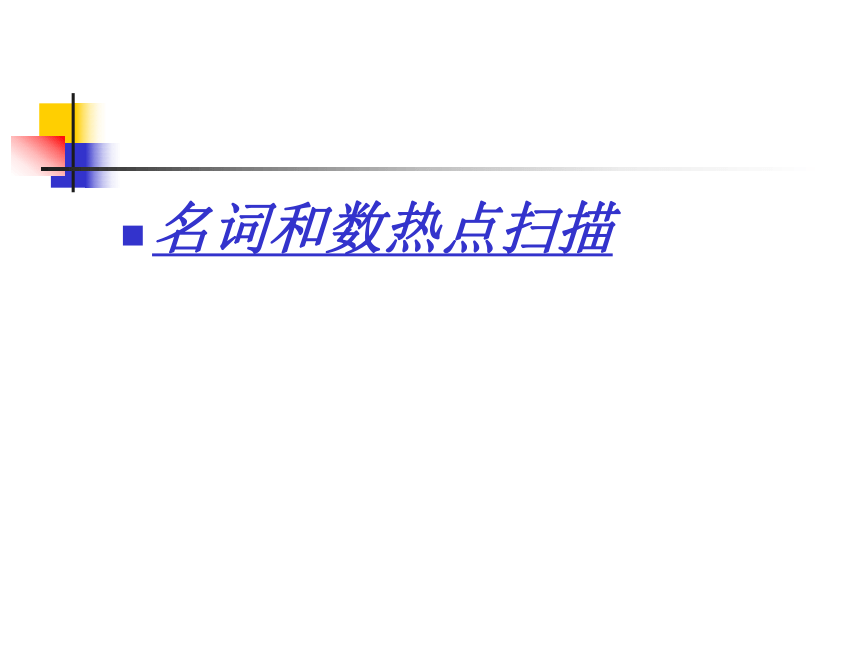

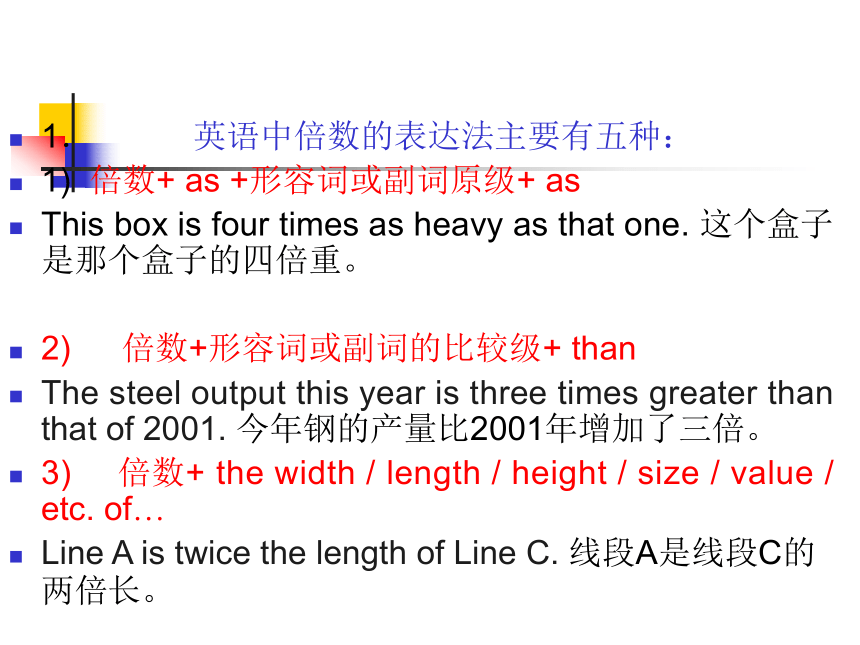
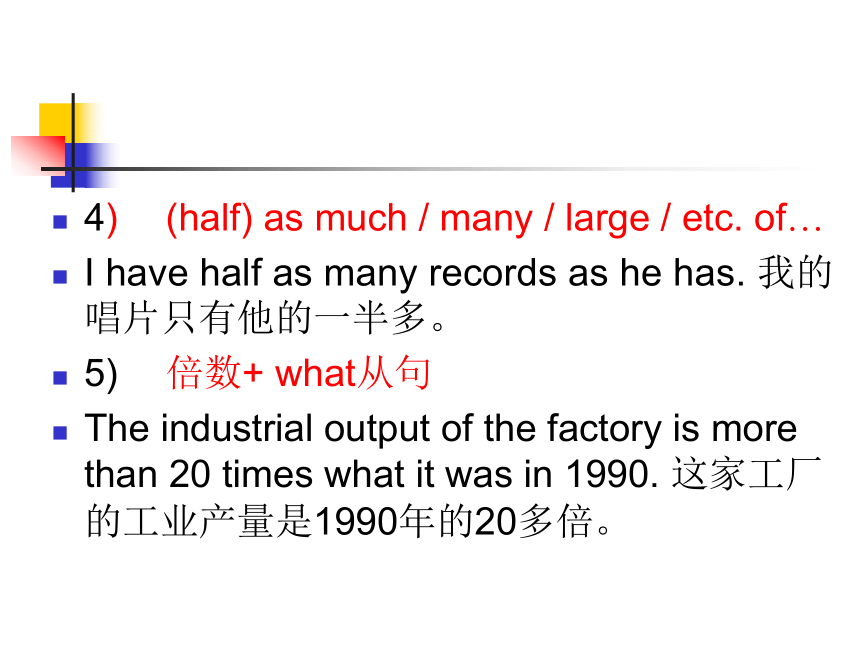
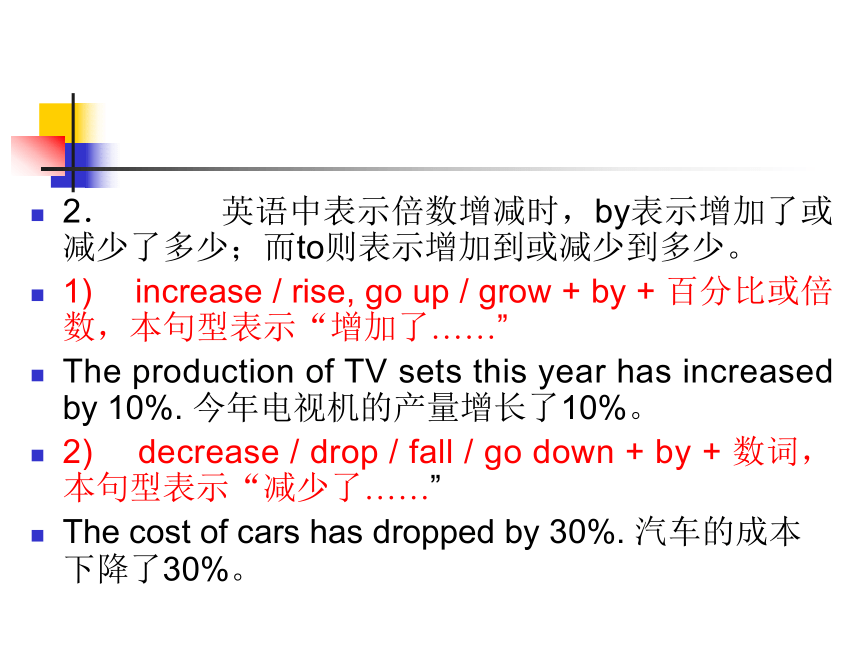
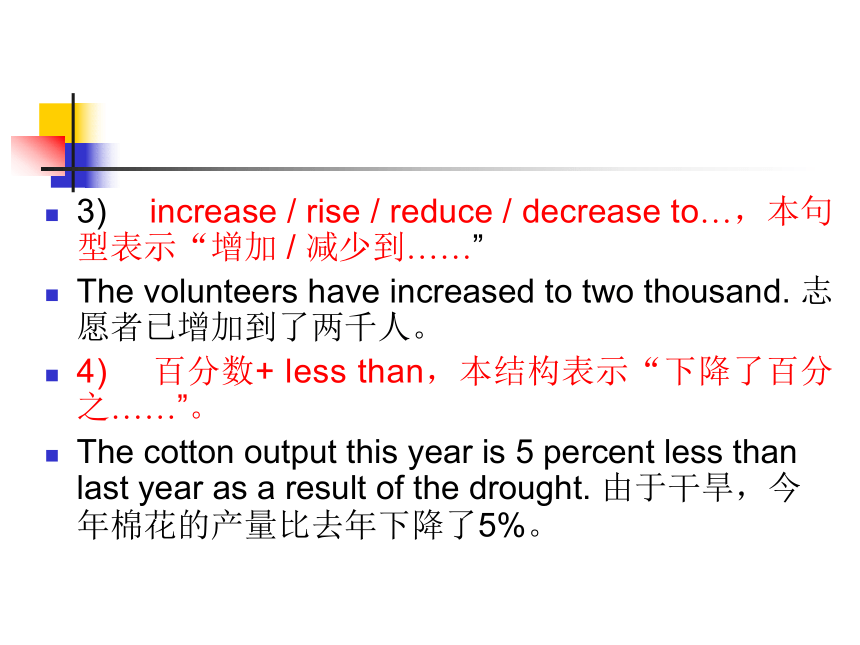
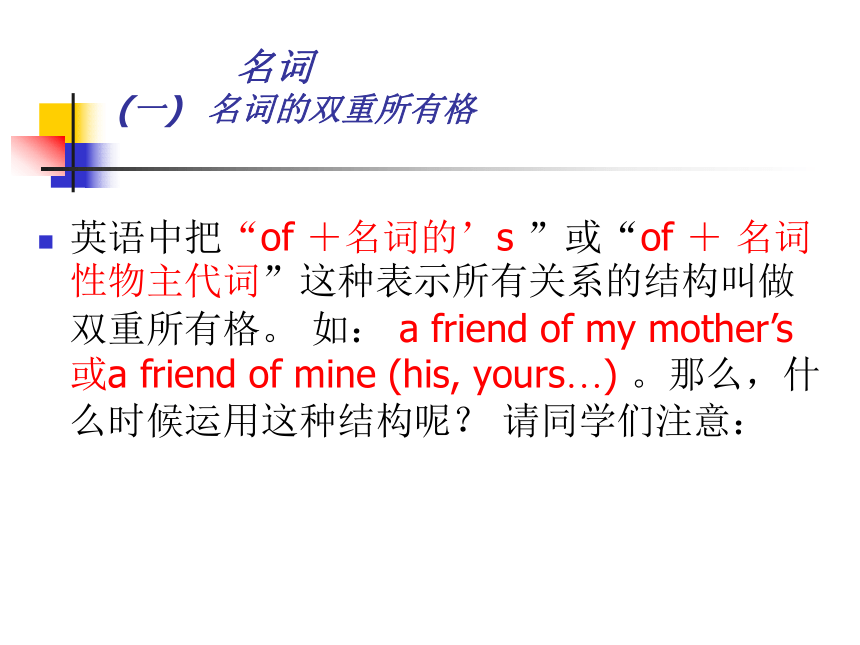


文档简介
课件22张PPT。名词和数热点扫描 数词 倍数及倍数增减的表达法 1.??????????? 英语中倍数的表达法主要有五种:
1) 倍数+ as +形容词或副词原级+ as
This box is four times as heavy as that one. 这个盒子是那个盒子的四倍重。
2)???? 倍数+形容词或副词的比较级+ than
The steel output this year is three times greater than that of 2001. 今年钢的产量比2001年增加了三倍。
3)???? 倍数+ the width / length / height / size / value / etc. of…
Line A is twice the length of Line C. 线段A是线段C的两倍长。 4)???? (half) as much / many / large / etc. of…
I have half as many records as he has. 我的唱片只有他的一半多。
5)???? 倍数+ what从句
The industrial output of the factory is more than 20 times what it was in 1990. 这家工厂的工业产量是1990年的20多倍。 2.??????????? 英语中表示倍数增减时,by表示增加了或减少了多少;而to则表示增加到或减少到多少。
1)???? increase / rise, go up / grow + by + 百分比或倍数,本句型表示“增加了……”
The production of TV sets this year has increased by 10%. 今年电视机的产量增长了10%。
2)???? decrease / drop / fall / go down + by + 数词,本句型表示“减少了……”
The cost of cars has dropped by 30%. 汽车的成本下降了30%。 3)???? increase / rise / reduce / decrease to…,本句型表示“增加 / 减少到……”
The volunteers have increased to two thousand. 志愿者已增加到了两千人。
4)???? 百分数+ less than,本结构表示“下降了百分之……”。
The cotton output this year is 5 percent less than last year as a result of the drought. 由于干旱,今年棉花的产量比去年下降了5%。 ? 名词 (一)? 名词的双重所有格 英语中把“of +名词的’s ”或“of + 名词性物主代词”这种表示所有关系的结构叫做双重所有格。 如: a friend of my mother’s 或a friend of mine (his, yours…) 。那么,什么时候运用这种结构呢? 请同学们注意:a, two, this that, these, those, some, any, such, no, each, every, which, what, several 等词与所有格名词同时修饰一个名词的时候,就需要用双重所有格。
如: any friend of Tom’s (汤姆的任何一位朋友), some houses of my father’s (我父亲的一些房子),two books of my father’s (我父亲的两本书)。 在具体使用双重所有格结构中,应该注意并且掌握以下几点:
1.双重所有格常表示全体中的“一部分”。 所谓全体中的一部分与“one of / some of…” 在意义上一致。
如: a friend of my sister’s = one of my sister’s friends,
some books of mine = some of my books, many friends of John’s = many of John’s friends。 2.? 双重所有格常用来加强语气, 有时候含有感彩。 特别表现在双重所有格所修饰的名词(即of 短语前面的那个名词)与指示代词连用时,往往带有赞赏,厌恶,不满等感彩,这时并不表示部分的意思。如:
That little daughter of your aunt’s is really a dear. 你姑妈的那个小女儿真逗人喜爱。 (比your aunt’s little daughter含有更多赞美的意味)
That silly uncle of yours has told me the same joke for three times. 你那位愚蠢的叔叔已经把同一个笑话给我讲了三遍。 (比your silly uncle 表现出更多的厌烦。)
That brother of mine is looking for trouble. 我那位兄弟又来找麻烦。 (比my brother 表现出更大的不满。 3.在双重所有格中,冠词the 一般不用于双重所有格结构的开头。
如: that new dress of Susan’s, 其中that 就不能用the代替。 但是双重所有格结构后有定语从句修饰的时候,the 可以用于开头。
如: The friend of my father’s who is going abroad. 我父亲一位将要出国的朋友。
4. 在双重所有格中,带有’s所有格的名词必须是一个明确限定而又是指人的名词。
我们可以说 a friend of my sister’s, a pen of Mary’s , a book of the nurse’s;
但是不能说a composition of a student’s, a leg of the table’s. 5.? 在无上下文的单句中,用双重所有格或者of 表示的所有格都可以,只是侧重不同。 注意意思上的区别。如:
He is an old friend of my brother’s. 着重说明我哥哥有好几位朋友。他是其中之一。
He is an old friend of my brother. 说明是我哥哥的老朋友,不是别人的老朋友,强调关系友好。
This is a picture of my mother’s 指的是我妈妈所拥有的照片。
This is a picture of my mother. 指的是我妈妈本人的照片。 二 集体名词的分类 在英语的名词中,有一些名词表示的是对一类事物的总称,我们把这些名词叫做集体名词。集体名词用作句子的主语时,一定要注意谓语的数。我们可以把集体名词分为以下三类: 1.用作不可数名词的集体名词。
如:jewellery(珠宝),machinery(机械),poetry(诗歌),fruit(水果),clothing(服装),furniture(家具),equipment(设备),mankind(人类)等.
这些名词用作句子的主语时,谓语动词要采用单数形式。若要表示一件(个)时,需要加a piece of 之类的修饰语,或者用表示具体意义的相应可数名词。
如:jewel,machine,poem,apple,dress,table等。
The jewellery in this shop is very expensive.这个店里的珠宝非常贵
Mr. Johnson gave her a jewel.(a piece of jewellery) 约翰狲先生送给她一件珠宝
A satellite is one of the most expensive pieces of scientific equipment in the world. 卫星是世界上最昂贵的科学配件之一
2. 用作复数的集体名词。
如:people(人们),youth(青年们),police(警察们),cattle(牛群)等,这些名词形式上是单数,但却是复数名词,一般不和不定冠词“a”连用。这些名词做句子主语时,谓语动词常采用复数形式。a people 是指“一个民族”,a youth是指“一个男青年”。如:
The police were searching for the murderer. 警察正在捉拿那个杀人犯
The youth are more energetic and enthusiastic 年轻人更具有活力和热情 3. 用作单数或复数的集体名词。
如:class(班机),family(家庭),team(队),audience(观众),enemy(敌人),public(公众)等,这些名词用作句子的主语时,如果强调集体中的每个成员,谓语动词用复数。如果强调一个整体,谓语动词用单数。如:
The team were busy preparing for the match. 队里正忙着准备比赛
The football team has a long history.足球队有很长历史了 (三) 抽象名词和物质名词得集体化 英语中,一些抽象名词和一些物质名词本身是不可数的,但是它们在一定的场合可以具体化为集体名词,这是高考的热点,也是考生的复习难点,考生务必掌握一定的规律并持之以恒地积累,现把英语中常见地这类名词归纳如下: 1.?????? 表示抽象地特性, 状态,思维,行为地一次,一种,一类,一下,一顿等,这是常组成”a/the+抽象名词”或”a/an+形容词+抽象名词”.如:
The peasants in the past lived a hard life. 过去地农民过着艰苦地生活.
Do you care for a smoke? 抽支烟好吗?
Can I take a look at your new car? 我能看一看你地新车吗?
Let’s go out for a walk/a drive. 咱们出去散散步/开车出去兜兜风.
I had a short sleep just now. 刚才我小睡了一会儿.
He took a great interest in English. 他对英语很感兴趣.
There was a heavy rain last night. 昨天晚上下了一场大雨.
I had a good time in the park last week. 上周我在公园犁玩得非常快乐.
His face is pale. He is in need of a rest. 他脸色苍白,需要休息. 2.?????? 表示具有某种特性,状态,特点,情感,情绪得人或事,表示变化了得词义,这一类抽象名词已经完全变成为可数名词.如:
in surprise(惊奇)?a surprise(令人惊奇的事), cold(寒冷)?a cold(感冒), light(光)?a light(灯), pleasure(愉快,高兴)?a pleasure(乐事),have pity on sb. (同情,怜悯)?It’s a pity(可怜得事),failure(失败)?a failure(失败的人或事), success(成功)?a success(成功的人或事), honour(荣誉)?an honour(一个带来荣幸得人或事),experience (经验)– an experience (一次经历), condition (状况) – conditions (环境,条件), must (必须)– a must (必要的事), difficulty (困难)– difficulties (困难的事), youth (青春) – a youth (年轻人), beauty (美丽)– a beauty (美人), wonder (惊奇 – a wonder (奇迹), danger (危险)– a danger (危险物), interest (兴趣)– interests (爱好), trade (买卖)– a trade (一桩买卖), joy (高兴)– a joy (乐事)等。
Oh, John, what a pleasant! 哦,约翰,多让人高兴的事啊!
Your daughter is quite a beauty. 你女儿是很美的人。
Looking after the grandson is a great joy of the old couple. 照看小孙子是老两口的乐事。 3. 在口语中, 有部分物质名词也可以具体化为可数名词。如:
drink (饮料)– a drink (一杯饮料), coffee (咖啡)– a coffee (一杯咖啡), ice (冰)– an ice (一份冰激凌), chalk (粉笔)– a chalk (一支粉笔), tea (茶)– a tea (一杯茶), sugar (糖)– a sugar (一块糖), paper (纸)– a paper (一张报纸,一篇论文), hair (头发)– a hair (一根头发)等。
Few pleasures can equal that of a cool drink on a hot day. 烈日下没有比一杯冷饮更让人愉快的了。
I’d like two teas. 给我来两杯茶。4. 有些不可数名词的复数形式可以表示特别的意义。如:
work (工作)– works (作品,著作), manner (方式,态度)– manners (礼貌), sand (沙子)– sands (沙滩,沙地), force (力量)– forces (军队), time (时间)– times (时代), wood (木头)– woods (森林)等。
He gained his wealth by printing works of famous writers. 印制著名作家的作品使他得了一大笔钱。
The boys are playing on the sands. 男孩们正在沙滩上玩呢。
5. 有些物质名词以复数形式出现,表示不同的类别。如:
teas (各种茶), silks (各种丝绸), fruits (各种水果,果实), a lot of fishes (许多种鱼), foods (各种食品)等。
Thank you for your attention!
1) 倍数+ as +形容词或副词原级+ as
This box is four times as heavy as that one. 这个盒子是那个盒子的四倍重。
2)???? 倍数+形容词或副词的比较级+ than
The steel output this year is three times greater than that of 2001. 今年钢的产量比2001年增加了三倍。
3)???? 倍数+ the width / length / height / size / value / etc. of…
Line A is twice the length of Line C. 线段A是线段C的两倍长。 4)???? (half) as much / many / large / etc. of…
I have half as many records as he has. 我的唱片只有他的一半多。
5)???? 倍数+ what从句
The industrial output of the factory is more than 20 times what it was in 1990. 这家工厂的工业产量是1990年的20多倍。 2.??????????? 英语中表示倍数增减时,by表示增加了或减少了多少;而to则表示增加到或减少到多少。
1)???? increase / rise, go up / grow + by + 百分比或倍数,本句型表示“增加了……”
The production of TV sets this year has increased by 10%. 今年电视机的产量增长了10%。
2)???? decrease / drop / fall / go down + by + 数词,本句型表示“减少了……”
The cost of cars has dropped by 30%. 汽车的成本下降了30%。 3)???? increase / rise / reduce / decrease to…,本句型表示“增加 / 减少到……”
The volunteers have increased to two thousand. 志愿者已增加到了两千人。
4)???? 百分数+ less than,本结构表示“下降了百分之……”。
The cotton output this year is 5 percent less than last year as a result of the drought. 由于干旱,今年棉花的产量比去年下降了5%。 ? 名词 (一)? 名词的双重所有格 英语中把“of +名词的’s ”或“of + 名词性物主代词”这种表示所有关系的结构叫做双重所有格。 如: a friend of my mother’s 或a friend of mine (his, yours…) 。那么,什么时候运用这种结构呢? 请同学们注意:a, two, this that, these, those, some, any, such, no, each, every, which, what, several 等词与所有格名词同时修饰一个名词的时候,就需要用双重所有格。
如: any friend of Tom’s (汤姆的任何一位朋友), some houses of my father’s (我父亲的一些房子),two books of my father’s (我父亲的两本书)。 在具体使用双重所有格结构中,应该注意并且掌握以下几点:
1.双重所有格常表示全体中的“一部分”。 所谓全体中的一部分与“one of / some of…” 在意义上一致。
如: a friend of my sister’s = one of my sister’s friends,
some books of mine = some of my books, many friends of John’s = many of John’s friends。 2.? 双重所有格常用来加强语气, 有时候含有感彩。 特别表现在双重所有格所修饰的名词(即of 短语前面的那个名词)与指示代词连用时,往往带有赞赏,厌恶,不满等感彩,这时并不表示部分的意思。如:
That little daughter of your aunt’s is really a dear. 你姑妈的那个小女儿真逗人喜爱。 (比your aunt’s little daughter含有更多赞美的意味)
That silly uncle of yours has told me the same joke for three times. 你那位愚蠢的叔叔已经把同一个笑话给我讲了三遍。 (比your silly uncle 表现出更多的厌烦。)
That brother of mine is looking for trouble. 我那位兄弟又来找麻烦。 (比my brother 表现出更大的不满。 3.在双重所有格中,冠词the 一般不用于双重所有格结构的开头。
如: that new dress of Susan’s, 其中that 就不能用the代替。 但是双重所有格结构后有定语从句修饰的时候,the 可以用于开头。
如: The friend of my father’s who is going abroad. 我父亲一位将要出国的朋友。
4. 在双重所有格中,带有’s所有格的名词必须是一个明确限定而又是指人的名词。
我们可以说 a friend of my sister’s, a pen of Mary’s , a book of the nurse’s;
但是不能说a composition of a student’s, a leg of the table’s. 5.? 在无上下文的单句中,用双重所有格或者of 表示的所有格都可以,只是侧重不同。 注意意思上的区别。如:
He is an old friend of my brother’s. 着重说明我哥哥有好几位朋友。他是其中之一。
He is an old friend of my brother. 说明是我哥哥的老朋友,不是别人的老朋友,强调关系友好。
This is a picture of my mother’s 指的是我妈妈所拥有的照片。
This is a picture of my mother. 指的是我妈妈本人的照片。 二 集体名词的分类 在英语的名词中,有一些名词表示的是对一类事物的总称,我们把这些名词叫做集体名词。集体名词用作句子的主语时,一定要注意谓语的数。我们可以把集体名词分为以下三类: 1.用作不可数名词的集体名词。
如:jewellery(珠宝),machinery(机械),poetry(诗歌),fruit(水果),clothing(服装),furniture(家具),equipment(设备),mankind(人类)等.
这些名词用作句子的主语时,谓语动词要采用单数形式。若要表示一件(个)时,需要加a piece of 之类的修饰语,或者用表示具体意义的相应可数名词。
如:jewel,machine,poem,apple,dress,table等。
The jewellery in this shop is very expensive.这个店里的珠宝非常贵
Mr. Johnson gave her a jewel.(a piece of jewellery) 约翰狲先生送给她一件珠宝
A satellite is one of the most expensive pieces of scientific equipment in the world. 卫星是世界上最昂贵的科学配件之一
2. 用作复数的集体名词。
如:people(人们),youth(青年们),police(警察们),cattle(牛群)等,这些名词形式上是单数,但却是复数名词,一般不和不定冠词“a”连用。这些名词做句子主语时,谓语动词常采用复数形式。a people 是指“一个民族”,a youth是指“一个男青年”。如:
The police were searching for the murderer. 警察正在捉拿那个杀人犯
The youth are more energetic and enthusiastic 年轻人更具有活力和热情 3. 用作单数或复数的集体名词。
如:class(班机),family(家庭),team(队),audience(观众),enemy(敌人),public(公众)等,这些名词用作句子的主语时,如果强调集体中的每个成员,谓语动词用复数。如果强调一个整体,谓语动词用单数。如:
The team were busy preparing for the match. 队里正忙着准备比赛
The football team has a long history.足球队有很长历史了 (三) 抽象名词和物质名词得集体化 英语中,一些抽象名词和一些物质名词本身是不可数的,但是它们在一定的场合可以具体化为集体名词,这是高考的热点,也是考生的复习难点,考生务必掌握一定的规律并持之以恒地积累,现把英语中常见地这类名词归纳如下: 1.?????? 表示抽象地特性, 状态,思维,行为地一次,一种,一类,一下,一顿等,这是常组成”a/the+抽象名词”或”a/an+形容词+抽象名词”.如:
The peasants in the past lived a hard life. 过去地农民过着艰苦地生活.
Do you care for a smoke? 抽支烟好吗?
Can I take a look at your new car? 我能看一看你地新车吗?
Let’s go out for a walk/a drive. 咱们出去散散步/开车出去兜兜风.
I had a short sleep just now. 刚才我小睡了一会儿.
He took a great interest in English. 他对英语很感兴趣.
There was a heavy rain last night. 昨天晚上下了一场大雨.
I had a good time in the park last week. 上周我在公园犁玩得非常快乐.
His face is pale. He is in need of a rest. 他脸色苍白,需要休息. 2.?????? 表示具有某种特性,状态,特点,情感,情绪得人或事,表示变化了得词义,这一类抽象名词已经完全变成为可数名词.如:
in surprise(惊奇)?a surprise(令人惊奇的事), cold(寒冷)?a cold(感冒), light(光)?a light(灯), pleasure(愉快,高兴)?a pleasure(乐事),have pity on sb. (同情,怜悯)?It’s a pity(可怜得事),failure(失败)?a failure(失败的人或事), success(成功)?a success(成功的人或事), honour(荣誉)?an honour(一个带来荣幸得人或事),experience (经验)– an experience (一次经历), condition (状况) – conditions (环境,条件), must (必须)– a must (必要的事), difficulty (困难)– difficulties (困难的事), youth (青春) – a youth (年轻人), beauty (美丽)– a beauty (美人), wonder (惊奇 – a wonder (奇迹), danger (危险)– a danger (危险物), interest (兴趣)– interests (爱好), trade (买卖)– a trade (一桩买卖), joy (高兴)– a joy (乐事)等。
Oh, John, what a pleasant! 哦,约翰,多让人高兴的事啊!
Your daughter is quite a beauty. 你女儿是很美的人。
Looking after the grandson is a great joy of the old couple. 照看小孙子是老两口的乐事。 3. 在口语中, 有部分物质名词也可以具体化为可数名词。如:
drink (饮料)– a drink (一杯饮料), coffee (咖啡)– a coffee (一杯咖啡), ice (冰)– an ice (一份冰激凌), chalk (粉笔)– a chalk (一支粉笔), tea (茶)– a tea (一杯茶), sugar (糖)– a sugar (一块糖), paper (纸)– a paper (一张报纸,一篇论文), hair (头发)– a hair (一根头发)等。
Few pleasures can equal that of a cool drink on a hot day. 烈日下没有比一杯冷饮更让人愉快的了。
I’d like two teas. 给我来两杯茶。4. 有些不可数名词的复数形式可以表示特别的意义。如:
work (工作)– works (作品,著作), manner (方式,态度)– manners (礼貌), sand (沙子)– sands (沙滩,沙地), force (力量)– forces (军队), time (时间)– times (时代), wood (木头)– woods (森林)等。
He gained his wealth by printing works of famous writers. 印制著名作家的作品使他得了一大笔钱。
The boys are playing on the sands. 男孩们正在沙滩上玩呢。
5. 有些物质名词以复数形式出现,表示不同的类别。如:
teas (各种茶), silks (各种丝绸), fruits (各种水果,果实), a lot of fishes (许多种鱼), foods (各种食品)等。
Thank you for your attention!
